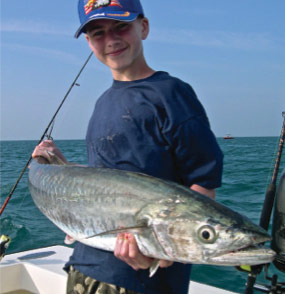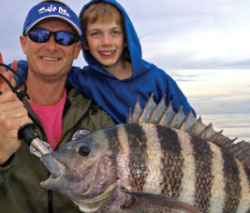The feel of offshore big game fishing can be found in a small boat just outside a pass. Even pier fishermen have learned how to get in on the ex- citement of catching large, fast swimming fish on light tackle.
The action happens twice a year. King mackerel migrate up our coastline in the spring headed for waters in the northern gulf and again in the fall as they head back south to the Keys. The migrations seem to coincide with water temperatures, the duration of daylight hours, and the availability of baitfish. Water temperatures around 72-74 degrees seem to be ideal but it may not be the kings that have this preference as much as the baitfish. The mackerel may possibly follow bait schools more than water temperature. For anglers, monitoring water temperatures may be the best way to stay in tune with concentrations of both bait and kings.
There a many fishing methods that are productive for catching kingfish. Each has it’s own benefits for any given scenario. When broken down into their lowest common denominator there are two ways to catch kings. One is with artificial lures the other is with live bait. The use of lures usually requires trolling and typically includes spoons, lipped div- ing plugs, or heavy jigs. Live bait fishing has several sub categories including slow trolling, drifting, and anchoring. The list of productive live baits is extensive including scaled sardines, threadfins, Spanish sardines, cigar minnows, blue runners, ladyfish, mullet, Spanish mackerel, and more.
When it comes to catch- ing big fish, referred to as “smokers”, it’s undis- puted that live bait fishing gets the nod. Troll- ing artificial “hardware” is great for locating and catching “schoolie” size fish but it’s always live baiters that score the big ones. Just talk to any seasoned tournament an- gler. They’ll confirm that frisky live bait is the key, and the bigger the better.
Smokers get their nickname from their scorching fast runs that could conceivably heat up a reels drag to the point of creating smoke. Sto- ries have been passed down for years of pour- ing seawater on reels to cool them down during the heat of battle. These larger fish tend to be loaners and spread out through the migration keeping the smaller fish schooled in concentra- tions. These big breeders are typically caught at the beginning and end of each migration. They are also found very close to shore, just outside the swim buoys along the beaches, and at extreme off- shore distances during the bulk of the migration. These facts tend to lead to a theory that the smokers form a pe- rimeter around the huge mass of king mackerel containing them as they march along their migration path.
For those anglers who can piece the puzzle of fishing together, the rewards are trophy pictures and possibly prize tournament money. For the rest of us, if you’re having fun catching fish, you’re doing it right.
Capt. Brent Gaskill is a 4th generation Tampa Bay native who fishes both inshore and offshore as a full-time guide. Call 727-510-1009 or e-mail captbrent@summervacationcharters.com. View his website at www.summervacationcharters.com for more information.
View the article with full imagery by clicking here.





